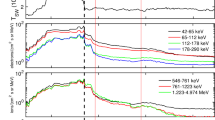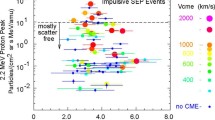Abstract
Our current understanding of the acceleration of solar-energetic particles is reviewed. The emphasis in this paper is on analytic theory and numerical modeling of the physics of diffusive shock acceleration. This mechanism naturally produces an energy spectrum that is a power law over a given energy interval that is below a characteristic energy where the spectrum has a break, or a rollover. This power law is a common feature in the observations of all types of solar-energetic particles, and not necessarily just those associated with shock waves (e.g. events associated with impulsive solar flares which are often described in terms of resonant stochastic acceleration). Moreover, the spectral index is observed to have remarkably little variability from one event to the next (about 50%). Any successful acceleration mechanism must be able to produce this feature naturally and have a resulting power-law index that does not depend on physical parameters that are expected to vary considerably. Currently, only diffusive shock acceleration does this.
Similar content being viewed by others
References
Alfvèn, H.: 1950, Phys. Rev. 77, 375.
Axford, W. I., Leer, E., and Skadron, G.: 1978, Proceedings of the 15th International Cosmic Ray Conference, Plovdiv, Bulgaria, vol. 11, p. 132.
Bell, A. R.: 1978, Mon. Not. R. Astron. Soc. 182, 147.
Blandford, R., and Ostriker, G.: 1978, Astrophys. J. 221, L29.
Emslie, A. G., Miller, J. A., and Brown, J. C.: 2004, Astrophys. J. 602, L69.
Fermi, E.: 1949, Phys. Rev. 75, 1169.
Fisk, L. A.: 1978, Astrophys. J. 224, 1048.
Giacalone, J.: 2003, Planet. Space Sci. 51, 659.
Giacalone, J.: 2005a, Astrophys. J. 624, 765.
Giacalone, J.: 2005b, Astrophys. J. 628, L37.
Giacalone, J., and Jokipii, J. R.: 1999, Astrophys J. 520, 204.
Jokipii, J. R.: 1982, Astrophys. J. 255, 716.
Jokipii, J. R.: 1987, Astrophys. J. 313, 842.
Kocharov, L., and Torsti, J.: 2003, Astrophys. J. 586, 1430.
Kóta, J., Manchester, W. B., De Zeeuw, D. L., Jokipii, J. R., and Gombosi, T. I.: 2006, Astrophys. J. submitted.
Krymsky, G. F.: 1977, Dokl. Akad. Nauk SSSR 234, 1306.
Lee, M. A.: 2005, Astrophys. J. Suppl. 158, 38.
Li, G., and Zank, G. P.: 2005, Geophys. Res. Lett. 32, L02101, doi:10.1029/2004GL021250.
Litvinenko, Y. E.: 1996, Astrophys. J. 462, 997.
Manchester, W. B., IV, Gombosi, T. I., De Zeeuw, D. L., Sokolov, I. V., Roussev, I. I., Powell, K. G., et al.: 2005, Astrophys. J. 622, 1225.
Miller, J. A.: 2000, ASP Conf. Ser. 206, 145.
Ng, C. K., Reames, D. V., and Tylka, A. J.: 2003, Astrophys. J. 591, 461.
Parker, E. N.: 1965, Planet. Space Sci. 13, 9.
Petrosian, V., and Liu, S.: 2004, Astrophys. J. 610, 550.
Reames, D. V.: 1988, Astrophys. J. 330, L71.
Reames, D. V.: 1999, Sp. Sci. Rev. 90, 413.
Sokolov, I. V., Roussev, I. I., Gombosi, T. I., Lee, M. A., Kóta, J., Forbes, T. G., et al.: 2004, Astrophys. J. 616, 171.
Swann, W. G. F.: 1933, Phys. Rev. 43, 217.
Syrovatsky, S. J.: 1960, JETP 13, 1257.
Tylka, A. J., Cohen, C. M. S., Dietrich, W. F., Lee, M. A., Maclennan, C. G., Mewaldt, R. A., et al.: 2005, Astrophys. J. 625, 474.
Zank, G. P., Rice, W. K. M., and Wu, C. C.: 2000, J. Geophys. Res. 105, 25,079.
Author information
Authors and Affiliations
Corresponding author
Rights and permissions
About this article
Cite this article
Giacalone, J., Kóta, J. Acceleration of Solar-Energetic Particles by Shocks. Space Sci Rev 124, 277–288 (2006). https://doi.org/10.1007/s11214-006-9110-1
Received:
Accepted:
Published:
Issue Date:
DOI: https://doi.org/10.1007/s11214-006-9110-1




